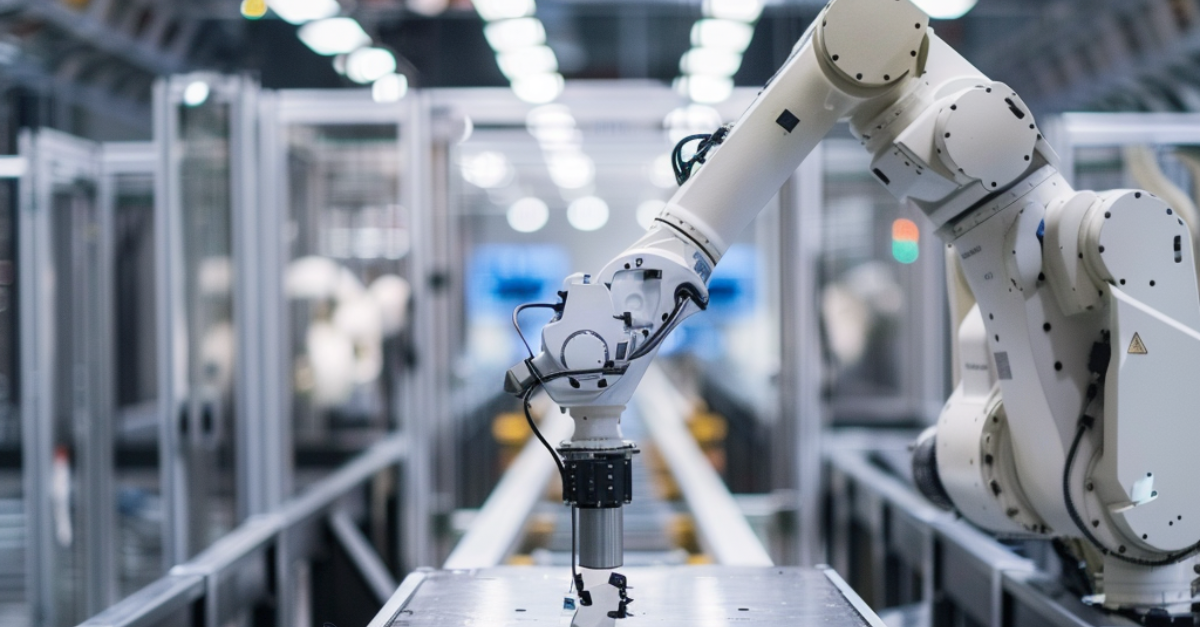The Future of Supply Chain Manufacturing Cycle
Imagine getting a packet of rice delivered to your doorstep in just a day. In our fast-paced world, technology has made this possible. Deliveries are happening in a blink of an eye, but have you ever wondered how that's achieved? The answer lies in the evolution of supply chain management.
From 1990s to early 2000s, a massive tech revolution and globalization spurred pioneering industrial growth. Supply chain management has been evolving ever since. In the present digital era, rapid advancements in technology and shifting market dynamics are marking the future of supply chain manufacturing look incredibly promising. We're talking about enhanced efficiency, resilience, and agility, all aimed at meeting customer needs and driving economic growth.
If you want to see your business excel, keep reading to explore the evolving digital supply chain management and logistics trends and discover how these changes are shaping the future.
What is Supply Chain?
Have you ever thought how the products you see on shelves lands in? if yes, then this blog is for you.
A product is an assembled version of raw materials. These raw materials under goes certain activities and processes at the respective stops to make its way to you. This whole process has an umbrella term, ‘Supply Chain’. Every product that reaches to you is a culmination of all the functions that captures the flow of goods and products from manufactures to the consumers. To convert the unfinished raw materials into finished products, a similar chain of process is followed.
Suppliers → Manufacturers → Distributors → Retailers → Consumers
"The network of organizations that are involved, through upstream and downstream linkages, in the different processes and activities that produce value in the form of products and services in the hands of the ultimate consumer."
In the 1990s, the advent of information technology and the internet revolutionized the way supply chains operate. Since then it has been ever evolving.
Understanding the Revolution of Digital Supply Chain Management
Supply chain management is the cornerstone of modern business. The supply chain ecosystem encompasses a wide range of functions, including procurement, production, warehousing, transportation, and distribution. Each of these elements must work in harmony to ensure the seamless flow of goods, information, and financial resources throughout the entire value chain.
As businesses strive to meet the ever-evolving demands of consumers, the need for agile, resilient, and technology-driven supply chain management has become increasingly evident. This is where the digital transformation of supply chain management comes into play, unlocking new possibilities for manufacturers, logistics providers, and businesses across various industries.
Digitalization is revolutionizing industries across the globe, fundamentally reshaping their structure, operations, and competitive landscapes. This transformation is evident in various aspects. Digital tools and technologies streamline processes, automate routine tasks, and optimize resource allocation, leading to increased productivity and reduced operational costs. Businesses can better understand customer needs and preferences through data analytics and AI-driven insights, thereby offering personalized products, services and improving customer satisfaction.
The Shift from Traditional to Digitalization Processes:
The traditional way involved manual processes which involved huge labour and human-error to meet the high demands eventually resulting in low production impacting our economy. Then, the primary focus was cost optimization and emphasis was laid more mover the inventory system. This resulted in limited visibility and co-ordination between the stakeholders.
To bridge this gap between the existing legacy system and new technologies, the digitalization brought certain key innovations that has helped business across the globe.
- IoT and Smart Sensors: This device enables real-time monitoring and predictive maintenance, for tracking goods in transites and automating tasks including the picking and packing of orders – helping companies to reduce the shipping mistakes.
- AI and Machine Learning: Use of these technologies can help you to analyse vast amounts of data, forecast demand, and manage inventory as per the needs arises.
- Blockchain: Ensures transparency and security in transactions, reducing fraud and improving traceability. It can help your business to reduce the risk of fraud and improve product safety.
- Robotics and Automation: Automated systems streamline production lines involves minimum human intervention. The automated vehicles allow long distance coverage, with increased output and reduced labour cost.
- Digital Prints: Customization has become an important factor. This technology can create virtual replicas of physical assets reducing the need for traditional supply chains and enabling companies to be more responsive to changing demand.
Challenges in Digitalizing Supply Chain Management
- Integration with Legacy Systems: One of the biggest challenges in digitalization is integrating new technologies with existing legacy systems. Many companies still rely on outdated software and hardware, making the transition to digital systems complex and costly.
- Data Security and Privacy: As supply chains become more digital, the amount of data generated increases exponentially. Ensuring the security and privacy of this data is crucial to prevent breaches and maintain trust among stakeholders.
- Recognizing the Skill Gap: The adoption of digital technologies requires a workforce skilled in using and managing these tools. Bridging the skill gap through training and development is essential for successful digital transformation
Impact of Digitalization on Supply Chain Manufacturing and Logistics
Supply chain manufacturing is a subset of supply chain management.
- Streamlined Production Processes: Digital technologies enable manufacturers to create more efficient and flexible production lines. For example, predictive maintenance powered by IoT sensors can identify potential equipment failures before they occur, reducing downtime and maintenance costs. AI-driven analytics can optimize production schedules, ensuring that resources are used efficiently and that products are delivered on time.
- Enhanced Logistics and Distribution: Digital logistics and supply chain management are transforming how goods are transported and distributed. Real-time tracking systems provide visibility into the location and condition of shipments, allowing for better coordination and timely deliveries. Automated warehouses use robotics to handle inventory, reducing human error and increasing throughput.
- Improved Collaboration and Communication: Digital platforms facilitate better communication and collaboration among all stakeholders in the supply chain, from suppliers and manufacturers to distributors and retailers. This interconnectedness ensures that everyone has access to the same information, leading to more coordinated efforts and faster problem resolution.
The Future Outlook
As we look ahead, the future of supply chain manufacturing is incredibly promising, driven by the continuous advancement and integration of cutting-edge technologies. Let's delve deeper into what this future holds.
Here are a few metrics that supply chain managers can monitor and manage to increase the effectiveness of the supply chain:
- Warehouse Costs: This metric involves all costs associated with warehouse operations. These could include rent, equipment, staff labor, software applications and many more. Businesses should monitor these costs and regularly see what areas they can actively reduce.
- Inventory timeframe: With managers tracking this metric, they can get a good indication of when they need to restock. It involves calculating the amount of stock a company intends to sell in a given time frame.
- Error-free order rates: The amount of successful orders clients receive that do not contain any problems. It is one of the most important metrics companies should pay attention to because it is directly related to building a strong consumer relationship.
- Cycle time: Cycle time is an essential metric business should track. A shorter cycle period means the supply chain is running more effectively, whereas if it is longer, it can indicate potential problems.
- Sales ratio: With companies tracking this metric, they can effectively order closer to the right amount of goods the business will need. In other words, it stops them from accidentally overstocking or understocking. They can calculate the sales ratio by dividing the amount of inventory the company has on hand by the amount they have sold and then multiplying the total by 100.
The Vision for Digitalization in Supply Chain Management
The future of supply chain manufacturing will see even greater adoption of advanced technologies. AI and machine learning will become more sophisticated, providing deeper insights and more precise predictions. IoT devices will become ubiquitous, offering real-time data on every aspect of the supply chain. This revolution can contribute to world’s economy in parallel to the environment’s sustainability.
- Greater Focus on Sustainability: Digitalization can also contribute to more sustainable supply chain practices. By optimizing routes and reducing waste, companies can minimize their environmental impact. Blockchain technology can ensure transparency in sourcing and production, promoting ethical practices.
- Reduced Carbon Footprint: Advanced logistics software will analyse multiple factors to determine the most efficient delivery routes, reducing fuel consumption and emissions. This not only lowers costs but also contributes to environmental sustainability.
- Smart Warehousing: Energy-efficient warehouses equipped with smart lighting, heating, and cooling systems will reduce energy consumption, further shrinking the carbon footprint of supply chain operations.
- Precision Production: With AI-driven demand forecasting, companies can produce only what is needed, significantly reducing waste. Excess inventory, which often ends up in landfills, will become a thing of the past.
- Sustainable Materials: Digital supply chain management will make it easier to source and use sustainable materials. Companies will have greater visibility into their supply chains, ensuring that all components are ethically sourced and environmentally friendly.
- Recycling and Reuse: The future will see a shift towards a circular economy, where products are designed for longevity, and materials are recycled and reused. Digital platforms will facilitate the tracking and management of materials throughout their lifecycle, promoting sustainability.
Autonomous Supply Chain: The Future
The potential for autonomous supply chains is enormous. As, AI and robotics technology continues to advance, these systems will become even more capable and reliable. We can expect to see more widespread adoption across various industries, from manufacturing and retail to healthcare and logistics.
In the near future, supply chains could become almost entirely self-sufficient, requiring minimal human oversight. This will free up human workers to focus on more strategic tasks, such as planning, innovation, and customer engagement. Ultimately, the rise of autonomous supply chains will not only drive efficiency and cost savings but also open up new opportunities for business growth and innovation.
The journey towards fully autonomous supply chains is just beginning, but the benefits are already clear. By embracing this technology, businesses can stand out, ensuring they remain competitive in an increasingly digital world.
Rise of Autonomous Supply Chains
Google research found that 82% of manufacturing organizations that are considering or already using gen AI agree that it will bring significant or transformative change to the industry. Top use cases include events monitoring, customer service automation, and document search and synthesis. We predict that genAI will prove significant in manufacturing, in the preceding years. Thus, autonomous supply chains, powered by AI and robotics, will become more prevalent. These systems can operate with minimal human intervention, making decisions based on real-time data and machine-learning algorithms. This will lead to greater efficiency and responsiveness in supply chain management.
Conclusion
The future of supply chain manufacturing is bright, with digital technologies driving unprecedented levels of efficiency, transparency, and collaboration. As companies continue to embrace digital supply chain management, they will be better equipped to meet the demands of a rapidly changing market. The integration of IoT, AI, blockchain, and other innovations will not only streamline operations but also pave the way for more sustainable and resilient supply chains. Embracing these advancements is crucial for staying competitive in the evolving landscape of global manufacturing and logistics.
If you want to be the leader of tomorrow, transform your business with a digitalized approach. It can enhance your supply chain operations, ensuring they remain agile and responsive to the needs of your customers. To learn more about how you can leverage digital technologies to transform your supply chain and manufacturing operations, schedule a consultation with our expert team today. Let’s not wait for another tomorrow and take this step today, to thrive in the digital age through your business models.
Recent Posts







Add Comment
0 Comments